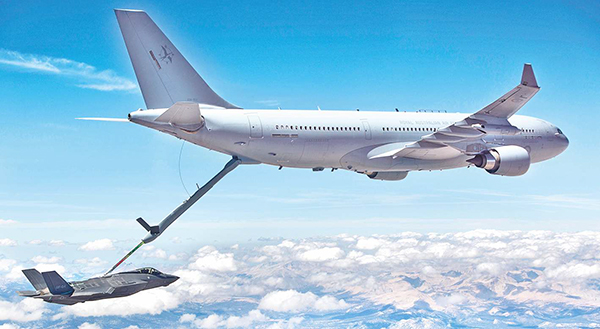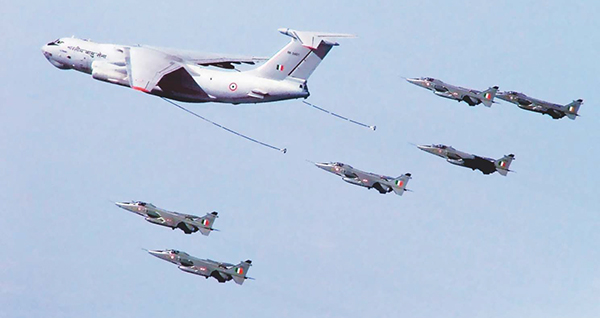Flight Refuelling Aircraft (FRA) are viewed as combat enablers and/or force multipliers for any air force, and particularly the Indian Air Force (IAF) in the eastern sector. India is expected to spend around US$3.2 billion on military transport aircrafts over the next 10 years by deploying the Avro Replacement programme (tactical airlift), Flight Refueling Aircraft (tanker) and Airborne Early Warning and Control (AEW&C) programme.
In the Avro Replacement programme (tactical airlift), Airbus’ C-295 aircraft has been selected with commercial negotiations completed and only the approval of the Cabinet Committee of Security is awaited. The AEW&C aircraft programme has received an acceptance of necessity (AoN) from the Defence Acquisition Council (DAC) for procurement of two Airbus A330 aircrafts in a green configuration (ie, a bare aircraft with no special type of equipment already fitted on board) with the mission systems and sub-systems being indigenously designed, developed and integrated onto the main platforms by the Defence Research and Development Organisation (DRDO). However, unlike the other programmes, the FRA programme has seen continuous delays twice despite Airbus’ A330 Multi-Role Tanker Transport (MRTT) being designated as the preferred bidder on both the occasions.
Current Operations
The IAF currently operates six IL-78M tanker aircrafts that it acquired from Russia. To supplement its current fleet of combat aircraft in current and forecasted operational scenarios, the IAF wants to acquire another six of these aircrafts. However, there are maintenance issues with this platform. According to a CAG report released in August 2017, the IL-78’s serviceability was at 49%. This translates into less than half of all aircrafts in the IAF’s fleet, which is why these aircrafts cannot be used for any mission at any given time. This is particularly alarming given the IAF’s requirement of serviceability is at least 70 per cent.
This low level of serviceability is primarily attributed to the poor availability of spares in Russia from Ilyushin, which has faced disruption since the fall of the USSR. In addition to this, the CAG also found that the refueling pods on the aircraft were beleaguered by failures, raising questions on its airworthiness. The report also pointed out issues in the aircraft’s fuel tank, its inability to fuel up completely, and the inadequacy pertaining to the number of hangars to house these aircrafts.
FRA Programme
Given the concern around the Il-78’s serviceability, the IAF launched the first edition of the FRA programme in 2006-2007. The two aircrafts that were under consideration were the IL-78 and Airbus’ A330 MRTT. The A330 MRTT was a derivative of Airbus’ popular wide-body commercial airliner, the A330. Even though A330 MRTT was more expensive than the IL-78M, it had certain advantages such as lower operating costs and a higher capacity to carry fuel (111 tonnes vs the IL-78s estimated capacity of 100 tonnes). Besides these, the A330 MRTT had the certification to use two types of refueling systems. One being the hose and drogue system and other, the flying boom. In the former’s case, a refueller transfers fuel to a probe extending from the receiving aircraft, whereas in the latter’s case, the fuel is transferred to a receptacle on the receiving aircraft’s fuselage. The flying boom is typically found on US-origin aircrafts.
Since the IAF utilizes a range of different platforms, some of which are manufactured by OEMs in Russia, the US, Europe, etc., a choice in mid-air fuel transfer provides them with the flexibility and a higher degree of interoperability with the different platforms. In May 2009, the IAF shortlisted the A330 MRTT for acquisition with negotiations on the contract for the programme beginning shortly thereafter, with the contract estimated to be worth US$1 billion. In January 2010, the Indian Government cancelled the tender over cost concerns, and a revised tender was issued later in that year for six refueling aircrafts with the same two aircrafts competing for the contract again. By January 2013, the cost of the contract had risen to around US$1.5 billion as the force opted for the Airbus A330 MRTT. The Indian Government though had doubts about the price and in July 2016, the MRTT deal with Airbus was cancelled due to “platforms being too expensive and not economically viable to operate.”
In January 2018, the IAF began the flight refueling aircraft again (for the third time) with the issuance of a Request for Information (RFI). A key requirement was the need for having a powerplant, which requires the platform to have two turbofan engines. This disqualified the IL-78M from the competition with the aircraft having four engines.
In the third edition of the programme, the aircraft that are likely to participate include Boeing’s KC-46A and Airbus A330 MRTT. Another competitor could also be Israel Aerospace Industries’ Bedek Aviation Group with its Boeing 767-200 multi-mission tanker transport (a conversion of the Boeing aircraft by Bedek Aviation). At present, the responses to the RFI have been submitted by interested OEMs, with an AoN from the DAC awaited to take the procurement process forward.
The current offset policy mandates an offset obligation of at least 30% on the value of the contract under the Buy (Global) category for procurement. This roughly would now translate into approx $600 million of offset obligations that the chosen OEM would incur from the programme. The acquisition of the FRA is likely to meet the IAF’s capabilities.
Key Considerations
Key considerations for the FRA programme are:
• The IAF has clearly highlighted its requirement for six more tankers, with an unstated but estimated requirement being at well over 20 aircrafts in the medium term.
• Airbus’ A330 MRTT is considered to be a capable platform, with it being in use with the forces of Singapore, South Korea, Australia, France, the UK, and the UAE. With increased competition from Boeing, Airbus may need to evaluate its offer to maintain a commercially attractive option. Airbus’ aircrafts do hold the advantage of being tested extensively by the IAF in the past two iterations of the programme.
The last two iterations of this programme did not see closure, despite Airbus being selected as a preferred bidder (on a technical basis). This highlights the intricacies of the costing for this particular deal, further emphasizing on the importance of the commercial offer from the bidders.
KC-46A Pegasus
The KC-46A Pegasus tanker has a self-protection suite, which provides electromagnetic pulse hardening, fuel tank ballistic protection and cockpit armor. It comes with defensive systems such as infrared countermeasures, radio frequency warning and night vision lighting. The tanker is also equipped with high resolution stereoscopic boom cameras. However, the most important feature is it’s refueling system which allows the tanker to refuel through a drogue system and refueling boom system. The drogue system is such that the KC-46 can conduct refueling through Wing Air Refueling Pods (WARPS) which have an offload rate of around 400 gallons per minute (GPM), the centre-line drogue system (CDS) also has an offload rate of 400 GPM while it maintains a degree of commonality with the WARPS re-fueling system.
In addition to this, the KC-46A tanker can also be equipped with an advanced fly-by-wire refueling boom, which has an offload rate of 1,200 GPM allowing it to have an extended range and flexibility.
There are certain multi-role capabilities within the tanker that allows it to be operated in three different configurations, including a passenger, cargo and aeromedical evacuation configuration.
Airbus A330 MRTT
Much like Boeing’s KC-46A tanker, the A330 MRTT also has the capability to be operable with a drogue and refueling system, with wing air refueling pods, a centreline drogue system and a refueling boom system. These three systems are classified as under-wing pods, fuselage refueling unit (FRU), and the aerial refueling boom system (ARBS), respectively. The aerial refueling boom system is primarily utilized to refuel receptacle-equipped aircraft such as the F-16, P-8I, C-17, etc. It has a fast fuel flow rate of 1200gal/min. The ARBS system is designed and manufactured by Airbus Defence and Space. The under-wing pods are a dual hose and drogue system that offers a high fuel offload rate of 420 gal/min. The pods are designed by Cobham (Cobham 905E). They incorporate a digitally controlled and electrically operated hose drum unit. This system is able to refuel any aircraft that has probe-equipped receivers, examples of platforms that it can refuel include the Eurofighter, Su-30 and Jaguar. The fuselage refueling unit is utilized to refuel large-probe equipped aircraft. It offers a high fuel offload rate of 600 gal/min. The FRU is a removable hose and drogue unit, which also allows refueling of the receiving aircraft with different types of fuel. The air-to-air refueling system is controlled through a console located in the cockpit, which features an enhanced vision system (EVS).
============
Gobal Market For Flight Refuelling Aircraft
The military tanker aircrafts or flight refueling aircraft fall under the broader market segment of military transport aircraft. Military transport aircrafts manage a variety of different roles/operational profiles. These operational profiles are usually catered to by different platforms/ aircraft and can be further segmented into broad areas such as, tactical airlift, strategic transports and tanker aircraft.
The global market value for tactical airlift, strategic transports and tanker aircraft is expected to reach approximately US$111 billion over the next 10 years (2019-2029). This value is driven by the forecasted expenditure (2019-2029) of the US, Canada, Brazil, Spain, France, Germany, Portugal, Saudi Arabia, Indonesia, Russia and India on military transport aircraft. The associated forecast spending of each geography and its corresponding market share over the next 10 years is highlighted in the table below.
Country Forecasted exp Market
on transport share (%)
USA 48,887 44.00%
Russia 8,975 8.10%
France 8,220 7.40%
S. Arabia 6,150 5.50%
Spain 3,450 3.10%
India 3,275 3.00%
Canada 2,810 2.50%
Brazil 2,645 2.40%
Indonesia 2,000 1.80%
Portugal 930 0.80%
New Zealand 792 0.70%
Others 22,866 20.60%
Total 1,11,000 100%
Source: EY





















[…] ALSO READ: Third Attempt at Adding Flight Refueling Aircrafts […]
[…] ALSO READ: Third Attempt at Adding Flight Refueling Aircrafts […]